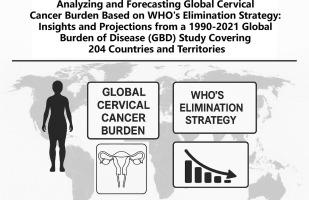Analyzing and forecasting global cervical cancer burden based on WHO’s elimination strategy: insights and projections from a 1990–2021 global burden of disease (GBD) study covering 204 countries and territories
IF 13
1区 综合性期刊
Q1 MULTIDISCIPLINARY SCIENCES
引用次数: 0
Abstract
Introduction
Cervical cancer remains a major global public health challenge. In 2018, the WHO launched a strategy to eliminate cervical cancer, emphasizing the need for precise epidemiological assessments.Objectives
This study utilized Global Burden of Disease (GBD) data to analyze the epidemiological indicators, geographical patterns, and temporal trends of cervical cancer, evaluating the global impact of the WHO’s strategy.Methods
Data on cervical cancer from 204 countries and territories (from 1990 to 2021) were retrieved from the GBD database. The year 2018, marking the WHO’s global call for elimination, was used to divide data into two periods: 1990 to 2018 and 2019 to 2021. Trends in age-standardized incidence rates and disability-adjusted life years (DALYs) were assessed using estimated annual percentage changes (EAPCs) and joinpoint regression. The socio-demographic index (SDI) was regressed against epidemiological indicators to explore disparities. Health inequality analyses recommended by the WHO were conducted, and an autoregressive integrated moving average (ARIMA) model was applied to predict future trends.Results
From 1990 to 2021, global age-standardized incidence rates and DALYs declined. During 1990 to 2018, the highest EAPC values were observed in Southern Sub-Saharan Africa (2·18), East Asia (0·69), and Eastern Europe (0·31). After 2019, a more significant improvement was noted globally. Regression analyses revealed an SDI-related gradient, with low-SDI countries lagging. Health inequality analyses showed widening disparities. ARIMA projections indicated stable incidence rates in most regions but a continued decline in DALYs.Conclusion
The WHO’s strategy has contributed to a notable decline in cervical cancer burden, yet challenges persist in low-SDI regions. Strengthening global cooperation and resource allocation is essential for achieving elimination goals.

基于世卫组织消除战略的全球宫颈癌负担分析和预测:来自覆盖204个国家和地区的1990-2021年全球疾病负担研究的见解和预测
宫颈癌仍然是全球公共卫生面临的一项重大挑战。2018年,世卫组织启动了一项消除宫颈癌的战略,强调需要进行精确的流行病学评估。目的:本研究利用全球疾病负担(GBD)数据分析宫颈癌的流行病学指标、地理模式和时间趋势,评估世卫组织战略的全球影响。方法从GBD数据库中检索1990年至2021年204个国家和地区的宫颈癌数据。2018年标志着世卫组织全球消除疟疾的呼吁,并将数据分为两个时期:1990年至2018年和2019年至2021年。使用估计年百分比变化(EAPCs)和连接点回归评估年龄标准化发病率和残疾调整生命年(DALYs)的趋势。将社会人口统计指数(SDI)与流行病学指标进行回归,以探讨差异。进行了世界卫生组织推荐的健康不平等分析,并应用自回归综合移动平均(ARIMA)模型预测未来趋势。结果从1990年到2021年,全球年龄标准化发病率和DALYs下降。1990 - 2018年,撒哈拉以南非洲南部(2.18)、东亚(0.69)和东欧(0.31)的EAPC值最高。2019年之后,全球出现了更显著的改善。回归分析显示sdi相关梯度,低sdi国家滞后。健康不平等分析显示,差距正在扩大。ARIMA预测显示,大多数区域的发病率稳定,但伤残调整生命年继续下降。结论世卫组织的战略显著降低了宫颈癌负担,但在低sdi地区仍存在挑战。加强全球合作和资源分配对于实现消除目标至关重要。
本文章由计算机程序翻译,如有差异,请以英文原文为准。
求助全文
约1分钟内获得全文
求助全文
来源期刊

Journal of Advanced Research
Multidisciplinary-Multidisciplinary
CiteScore
21.60
自引率
0.90%
发文量
280
审稿时长
12 weeks
期刊介绍:
Journal of Advanced Research (J. Adv. Res.) is an applied/natural sciences, peer-reviewed journal that focuses on interdisciplinary research. The journal aims to contribute to applied research and knowledge worldwide through the publication of original and high-quality research articles in the fields of Medicine, Pharmaceutical Sciences, Dentistry, Physical Therapy, Veterinary Medicine, and Basic and Biological Sciences.
The following abstracting and indexing services cover the Journal of Advanced Research: PubMed/Medline, Essential Science Indicators, Web of Science, Scopus, PubMed Central, PubMed, Science Citation Index Expanded, Directory of Open Access Journals (DOAJ), and INSPEC.
 求助内容:
求助内容: 应助结果提醒方式:
应助结果提醒方式:


